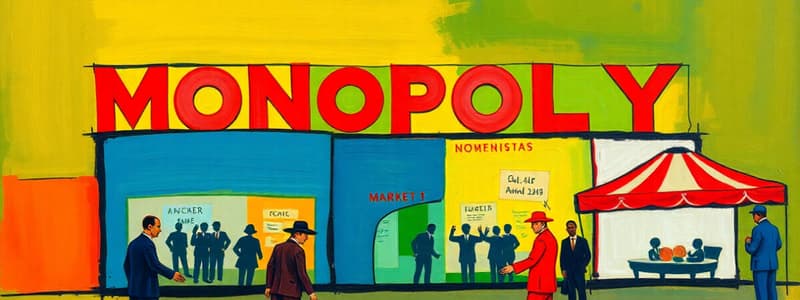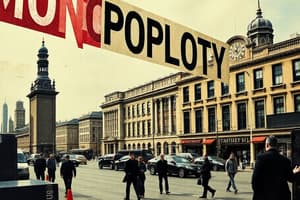Podcast
Questions and Answers
At which quantity does the total profit become zero?
At which quantity does the total profit become zero?
- 27
- 25
- 22 (correct)
- 23
What is the total revenue when the quantity is 25?
What is the total revenue when the quantity is 25?
- $2,208
- $2,288
- $2,250 (correct)
- $2,000
Which quantity results in the lowest total profit?
Which quantity results in the lowest total profit?
- 21
- 28 (correct)
- 20
- 29
What is the total cost when the quantity is 24?
What is the total cost when the quantity is 24?
What quantity yields a total profit of 20?
What quantity yields a total profit of 20?
What characterizes a Crown corporation in Canada?
What characterizes a Crown corporation in Canada?
What is the price and quantity when a monopolist is unregulated?
What is the price and quantity when a monopolist is unregulated?
How do barriers to entry affect monopolies?
How do barriers to entry affect monopolies?
What distinguishes monopolies from perfect competition?
What distinguishes monopolies from perfect competition?
Which is a method governments may use to control monopolies?
Which is a method governments may use to control monopolies?
What would be the total revenue for six haircuts if the barber practiced perfect price discrimination?
What would be the total revenue for six haircuts if the barber practiced perfect price discrimination?
How does a monopoly differ from perfect competition regarding price and output?
How does a monopoly differ from perfect competition regarding price and output?
What is one outcome of monopoly compared to perfect competition in terms of economic surplus?
What is one outcome of monopoly compared to perfect competition in terms of economic surplus?
What would indicate that a barber is utilizing perfect price discrimination?
What would indicate that a barber is utilizing perfect price discrimination?
What is the primary effect of a monopoly on long-term economic profits?
What is the primary effect of a monopoly on long-term economic profits?
In terms of quantity and price, what is a characteristic of monopolistic markets?
In terms of quantity and price, what is a characteristic of monopolistic markets?
What happens to producer surplus in a monopoly compared to perfect competition?
What happens to producer surplus in a monopoly compared to perfect competition?
What is deadweight loss in the context of monopolies?
What is deadweight loss in the context of monopolies?
What happens to consumer surplus when a monopolist practices price discrimination among two groups with differing elasticities of demand?
What happens to consumer surplus when a monopolist practices price discrimination among two groups with differing elasticities of demand?
What is the main outcome for total revenue when a monopolist applies different prices for groups with different elasticities of demand?
What is the main outcome for total revenue when a monopolist applies different prices for groups with different elasticities of demand?
Which of the following describes 'perfect price discrimination'?
Which of the following describes 'perfect price discrimination'?
If a monopolist charges $18 to a group with inelastic demand and $12 to a group with elastic demand, what is the result of their pricing strategy in terms of total revenue from both groups?
If a monopolist charges $18 to a group with inelastic demand and $12 to a group with elastic demand, what is the result of their pricing strategy in terms of total revenue from both groups?
In the context of price discrimination, what is the purpose of differentiating prices among units purchased?
In the context of price discrimination, what is the purpose of differentiating prices among units purchased?
What is the total revenue for six haircuts if a barber charges a flat price of $15 per haircut?
What is the total revenue for six haircuts if a barber charges a flat price of $15 per haircut?
What characterizes the different forms of price discrimination discussed?
What characterizes the different forms of price discrimination discussed?
What is a consequence of a monopolist implementing price discrimination compared to a single-price strategy?
What is a consequence of a monopolist implementing price discrimination compared to a single-price strategy?
What occurs at the output level where MR equals MC in a monopolistic market?
What occurs at the output level where MR equals MC in a monopolistic market?
Which of the following statements is true regarding a monopolist's pricing strategy?
Which of the following statements is true regarding a monopolist's pricing strategy?
How is total profit calculated for a monopolist?
How is total profit calculated for a monopolist?
What defines elastic demand in relation to total revenue?
What defines elastic demand in relation to total revenue?
In which scenario would a monopolist experience losses?
In which scenario would a monopolist experience losses?
What condition represents a break-even point for a monopolist?
What condition represents a break-even point for a monopolist?
Which of the following price and cost relationships indicates profitability for a monopolist?
Which of the following price and cost relationships indicates profitability for a monopolist?
If a monopolist's Total Revenue is decreasing and Total Cost is increasing, what can be inferred?
If a monopolist's Total Revenue is decreasing and Total Cost is increasing, what can be inferred?
At which quantity does a monopolist start making a profit according to the provided data?
At which quantity does a monopolist start making a profit according to the provided data?
Which of these describes the purpose of calculating Marginal Cost for a monopolist?
Which of these describes the purpose of calculating Marginal Cost for a monopolist?
What is one reason monopolies are considered beneficial?
What is one reason monopolies are considered beneficial?
What characterizes a natural monopoly?
What characterizes a natural monopoly?
What is the effect of a lump-sum profits tax on a monopolist?
What is the effect of a lump-sum profits tax on a monopolist?
Which of the following accurately describes a monopoly sales tax?
Which of the following accurately describes a monopoly sales tax?
What does the socially optimum price reflect?
What does the socially optimum price reflect?
What is the purpose of government price setting in relation to monopolies?
What is the purpose of government price setting in relation to monopolies?
Which statement about nationalization of a monopoly is true?
Which statement about nationalization of a monopoly is true?
How do public utilities differ from other monopolies?
How do public utilities differ from other monopolies?
Flashcards
Break-Even Point
Break-Even Point
The point at which total revenue equals total cost (TR = TC), resulting in zero profit.
Marginal Revenue (MR)
Marginal Revenue (MR)
The additional revenue generated from selling one more unit of a good or service.
Marginal Cost (MC)
Marginal Cost (MC)
The additional cost incurred from producing one more unit of a good or service.
Total Profit (π)
Total Profit (π)
Signup and view all the flashcards
Average Revenue (AR)
Average Revenue (AR)
Signup and view all the flashcards
Price Discrimination
Price Discrimination
Signup and view all the flashcards
Price Discrimination: Among Units Purchased
Price Discrimination: Among Units Purchased
Signup and view all the flashcards
Price Discrimination: Among Buying Groups
Price Discrimination: Among Buying Groups
Signup and view all the flashcards
Perfect Price Discrimination
Perfect Price Discrimination
Signup and view all the flashcards
Elasticity of Demand
Elasticity of Demand
Signup and view all the flashcards
Elastic Demand
Elastic Demand
Signup and view all the flashcards
Inelastic Demand
Inelastic Demand
Signup and view all the flashcards
Monopolist
Monopolist
Signup and view all the flashcards
Price Elasticity of Demand
Price Elasticity of Demand
Signup and view all the flashcards
Profit Maximization for a Monopolist
Profit Maximization for a Monopolist
Signup and view all the flashcards
Total Revenue (TR)
Total Revenue (TR)
Signup and view all the flashcards
Total Cost (TC)
Total Cost (TC)
Signup and view all the flashcards
Maximizing Total Revenue
Maximizing Total Revenue
Signup and view all the flashcards
Crown Corporation
Crown Corporation
Signup and view all the flashcards
Fair-Return Price
Fair-Return Price
Signup and view all the flashcards
Unregulated Monopoly Price
Unregulated Monopoly Price
Signup and view all the flashcards
Socially Optimum Price
Socially Optimum Price
Signup and view all the flashcards
Barriers to Entry
Barriers to Entry
Signup and view all the flashcards
Perfect Competition
Perfect Competition
Signup and view all the flashcards
Natural Monopoly
Natural Monopoly
Signup and view all the flashcards
Public Utilities
Public Utilities
Signup and view all the flashcards
Lump-sum Profits Tax
Lump-sum Profits Tax
Signup and view all the flashcards
Monopoly Sales Tax
Monopoly Sales Tax
Signup and view all the flashcards
Nationalization
Nationalization
Signup and view all the flashcards
Study Notes
Monopoly
- A monopoly is a market structure with a single firm that is the sole producer of a product with no close substitutes.
- The firm and the industry are one and the same.
- A monopolist has the ability to set the price, making them a price maker.
- They can choose either price or quantity, but not both.
- Monopolies exist due to barriers to entry.
Learning Objectives
- Explain how monopolies arise and why they need to reduce prices to sell more.
- Describe how a monopolist determines profit-maximizing output and price.
- Explain five criticisms of monopolies.
- Explain the key differences between monopoly and perfect competition.
- Describe ways governments can control a monopolist.
- Explain three justifications for monopolies.
Barriers to Entry
- These are obstacles that make it difficult or impossible for new firms to enter a market.
- Types of barriers include:
- Technical barriers (e.g., sole ownership of a scarce resource).
- Legal barriers (e.g., patents, copyrights, public franchises, licenses).
- Economic barriers (e.g., economies of scale).
Monopoly Characteristics
- Monopolies are protected from new competitors by barriers to entry.
- Example industries with barriers to entry: Computer operating systems, commercial aircraft manufacturing, West coast wild salmon fishing.
Monopolist's Gains and Losses
- To increase sales, a monopolist must lower the price on all units, resulting in a gain from selling more units but a loss due to lower prices.
- Marginal revenue is less than the price when a firm producing more output.
Total, Average, and Marginal Revenues
- Total revenue increases as more units are sold but starts to decrease eventually.
- Average revenue is identical to the demand curve.
- Total revenue is maximized when marginal revenue equals zero.
Monopoly and Elasticity
- The top of any demand curve is elastic.
- The bottom of any demand curve is inelastic.
- Monopolists will never produce where demand is inelastic.
Profit-Maximizing Output
- A monopolist maximizes profit where marginal revenue (MR) equals marginal cost (MC).
- Being a monopolist does not always ensure profitability.
Calculating Total Profits
- Profits are maximized when the difference between total revenue (TR) and total cost (TC) is greatest.
- The total profit curve (Tπ) is at its maximum when the slope of total revenue (TR) equals the slope of total cost (TC), which is where MR = MC.
Calculating Total Profits (Marginal Approach)
- A different method for calculating profit maximization uses marginal revenue and marginal cost.
Average and Marginal Costs and Revenues for Monpolists
- Break-even when average revenue (AR) equals average cost (AC).
- More profitable when AR > AC.
- Profit maximizing when MR=MC
Perfect Price Discrimination
- Customers are charged the maximum price they are willing to pay.
Monopoly vs. Competitive Markets
- In a competitive market, firms are price takers and produce at the equilibrium price where P = MC.
- Monopolies charge higher prices and produce lower quantities than competitive markets.
Economic Surplus: Perfect Competition vs. Monopoly
- Monopoly results in less consumer surplus, more producer surplus, and deadweight loss.
Key Concepts to Remember
- Definition of monopolies
- Barriers to entry
- Profit maximization
- Criticisms and defenses of monopolies
- Differences between monopolies and perfect competition
- Government control of monopolies
Studying That Suits You
Use AI to generate personalized quizzes and flashcards to suit your learning preferences.



